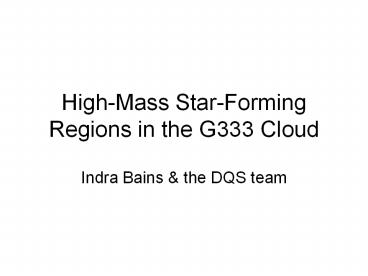High-Mass Star-Forming Regions in the G333 Cloud - PowerPoint PPT Presentation
1 / 16
Title:
High-Mass Star-Forming Regions in the G333 Cloud
Description:
13CO greyscale. MSX source. H2O maser. OH maser. HII region. 1.2 mm source. IRAS error ellipse ... T13 5 , T12 5 , T12/T13 1 (eg line centres) or T13 5 ... – PowerPoint PPT presentation
Number of Views:23
Avg rating:3.0/5.0
Title: High-Mass Star-Forming Regions in the G333 Cloud
1
High-Mass Star-Forming Regions in the G333 Cloud
- Indra Bains the DQS team
2
(No Transcript)
3
Source A CO channel maps
12CO contours, 13CO greyscale
4
A
Self-absorbed
12CO
13CO
Absorption features
CS
SiO
5
Source C molecular outflow
12CO
CS
CS
6
Source D molecular outflow
12CO
CS
7
Outflow analysis
- T13 gt 5?, T12 gt 5?, T12/T13 gt 1
- T12/T13 1-e??13/1-e?13 ?12??13 ? 45
- ?12 15-130
- Calculate Tex (12CO) N12 assuming all levels
thermalised etc - T13 gt 5?, T12 gt 5?, T12/T13 lt 1 (eg line centres)
or T13 gt 5?, T12 lt 5? - N13 in optically thin limit, Tex7.5 K
- T12 gt 5?, T13 lt 5?, (eg wings, larger spatial
offsets) - ?12 15, calculate Tex(12CO), N12
- M(x,y,v) mmol NH2 V(x,y,v) NH2 XNCO d3.6
kpc
8
Outflow properties
- Source C Mout 5.5e3 Mo (M1.2mm 7.2e3 Mo
Mookerjea et al 2004) - Source D Mout 2.1e3 Mo (M1.2mm 5.5e3 Mo)
- KE 1049 erg
9
ATCA observations
- Freq (MHz) typical beam (x) mode
- 1384 14.10 x 8.90 c
- 2368 8.37 x 5.22
c - 4800 4.37 x 2.23
c - 8640 2.36 x 1.22
c - 22369 0.83 x 0.58 RRL
c - 89209 2.16 x 1.75 HCO
c
10
Source C radio continuum
1384 MHz
2368 MHz
4800 MHz
8640 MHz
11
Source C SED
22 GHz
89 GHz
? 1.2
12
Source C properties
- 3 mm dust mass lower limit 6.6e3 Mo (Td 40 K),
1.4e4 Mo (Td 20 K) - c.f. 1.2 mm mass 4.6e3 Mo (Td 40 K Mookerjea
et al 2004) - 22 GHz deconvolved size 0.02 pc
- Assuming ?22GHz ltlt 1 (lower limit)
- Ni 4.4e48 s-1 1 ZAMS O7 (Panagia 1973)
- EM 1.4e9 pc cm-6
- ne 2.4e5 cm-3
- Mion 0.03 Mo
- Assuming vexp cs 11.4 km s-1 t 1e3 yr
- UCHII region
13
Source D radio continuum
2368 MHz
2368 MHz
4800 MHz
8640 MHz
14
Source D SED
22GHz
89 GHz
?23681384 3.0 ?86404800 0.6
15
Source D properties
- 3 mm dust mass lower limit 2.1e3 Mo (Td 40 K),
4.4e3 Mo (Td 20 K) - c.f. 1.2 mm mass 5.5e3 Mo (Td 40 K Mookerjea
et al 2004) - 22 GHz deconvolved size 0.03 pc
- Assuming ?22GHz ltlt 1 within resolution effects
- Ni 5.7e48 s-1 1 ZAMS O6.5 (Panagia 1973)
- EM 1.4e9 pc cm-6
- ne 2.1e5 cm-3
- Mion 0.1 Mo
- UCHII region
16
Summary
- G333 cloud contains massive bipolar outflows with
HII regions in the centre - Line modelling
- NANTEN2 observations of higher J transitions
- ATCA HCO data
- Obtaining 2 more RRLs to solve for broadening
terms, hence Te, ne etc in HII regions































